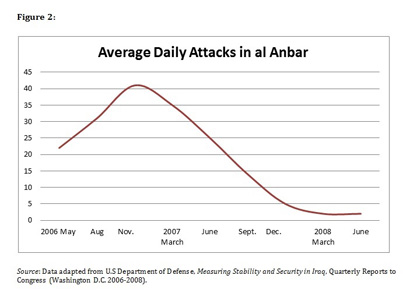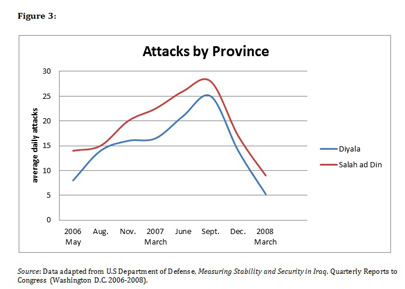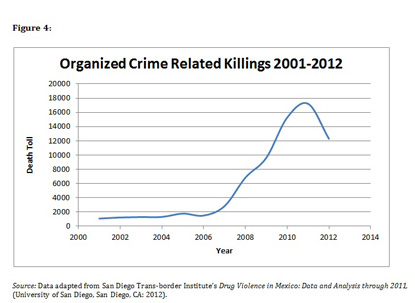Counterinsurgency Lessons for Mexico’s Drug War: Interpreting Spasms of Violence
Eric M. Tope
In his campaign for the Mexican Presidency, Enrique Peña Nieto vowed to transform the nation’s violent locales into “peaceful areas where Mexicans can travel safely without fear of loss to their liberty or life.”[i] While it is too early to determine if Peña Nieto will uphold his promise, any ease in drug related violence must be greeted with a modicum of caution. Reason being is that when confronting criminal or other pernicious organizations, violence levels can be a misleading metric of success. Counterintuitive as it may seem, sharp accelerations in violence are often indicative of aggressive security operations while lower levels can be a sign of government impotence or apathy. American and coalition forces encountered this predicament in Iraq while attempting to wrest control of the country from insurgents, and despite many months of intense conflict, great strides were made toward achieving that goal. Mexico’s quandary regarding the cartels is similar in some respects, and America’s experience in Iraq has some lessons to offer Mexican policymakers and citizens struggling to understand the recent explosion of violence.
Since 2006 exceptionally intense drug-related warfare has plagued Mexico and accumulated a death toll ranging from at least 50,000 to perhaps over 100,000 with an additional 20,000 missing.[ii] This violence has typically taken one of two forms: cartel vs. cartel or government vs. cartel, with the former being far more prevalent. The Sinaloa cartel, for instance, provoked a turf war with the Gulf cartel and the Zetas while trying to expand their operations into northeastern Mexico. Following that collision, several Sinaloa factions turned on one another in Culiacàn and prosecuted a civil war within their own organization[iii] By 2012, the Zetas, “in the most brazen offensive of the war,” had penetrated Sinaloa State introducing new levels of violence to the once stable area.[iv] As these observations suggest, cartels’ primary targets are most often rival traffickers. However, gangsters have not shied from engaging government officials either. In the past seven years, eighty-three police chiefs have been killed along with thirty-two mayors, and in 2009 La Familia cartel killed fifteen police officers following the apprehension of a key Lieutenant. “In these cases,” according to Ioan Grillo, “narco violence is a reaction to concrete strikes on criminal organizations. They are pressuring the state to back off and signaling they want a soft government who will not mess with their business.”[v] In other instances, cartels have simply recruited authorities. Sinaloa capos Chapo Guzman and Mayo Zambada struck alliances with federal police, and in 2009, La Familia attacked federal officers with the assistance of state police.
This preliminary evidence portrays a grim picture of Mexico’s drug war, however in the same period, former President Felipe Calderón took dramatic steps toward eroding the dominance of cartels throughout the country. Calderón deployed the Mexican Army in excessively problematic locales while he rebuilt federal, state and municipal law enforcement organizations that had been infiltrated or corrupted by cartel associates. The judicial and penal systems underwent reforms as well. This crackdown led to the capture or killing of forty major cartel members and the disruption of some of the country’s most violent organizations.[vi]
The preceding overview begs the question as to why such an aggressive counternarcotics campaign was accompanied by such extensive carnage. The answer has to do with the fact that violence levels alone reveal little when analyzing the efficacy of state efforts to curtail organized crime or similar threats. Nonviolence only indicates that some force is dominant in a city or region, but it does not tell us who. As such, relatively peaceful conditions may simply indicate that criminals or dissidents have overtaken an area to the extent that they are able to operate unimpeded. High degrees of violence, on the other hand, typically display that control of an area is being contested, either between government and insurgent forces or between opposing rebel groups. Therefore, as control of a locality comes under dispute, violence will trend upward for a time and eventually subside, provided one faction ultimately prevails. For example; once the Sinaloa cartel retreated from northeastern Mexico the once hazardous region remained placid, but only “under the iron grip of the Zetas.”[vii] Visually, this trend of violence resembles and inverted-U shape as depicted in figure 1.[viii]

Violence intensifies as security forces, or a rival gang upsets the status quo and the dissidents respond to the challenge. If security operations are effective, violence will ultimately abate as the troublemakers are defeated. However, a similar pattern will emerge if security forces withdraw and restore the previous balance, or if one collection of insurgents cedes control of the territory to the other. The key lesson here is that violence is only a useful metric if the context is fully comprehended.
A progression of violence similar to figure 1 recently materialized in Iraq when American forces began challenging insurgents for control of the country’s most dangerous provinces. Prior to 2006, al Qaeda in Iraq (AQI) and their local allies controlled large amounts of territory while American troops held up in Forward Operating Bases removed from major population centers. Beginning in 2006 and early 2007, the U.S. military commenced a tactical reorientation based on counterinsurgency doctrine. In accordance with the new approach, American soldiers abandoned fortified bases and saturated cities with a 24-hour-a-day presence in order to protect residents and undermine the insurgency. The increased presence of American personnel was met with an abrupt spark in attacks as AQI sought to neutralize the challenge to their authority. Notable increases of insurgent operations took place in Sunni provinces where AQI had established its strongest foothold.[ix] Figure 2 depicts the trend in violence throughout this period in al Anbar province; one of Iraq’s most volatile regions.
Throughout the summer of 2006, as the U.S. stepped up its presence, a steady acceleration of attacks is evident. In the following two months violence reached its climax as AQI desperately sought to beat back coalition advances. In the final weeks of 2006 violence began a steady descent which continued throughout all of 2007. By the close of 2007 AQI’s grip had been broken and attacks leveled off to an insignificant daily average.

Other Sunni provinces under AQI’s influence experienced comparable inflations and mitigations of attacks as they were retaken by coalition and Iraqi forces, which is depicted in figure 3.

As the data from Iraq demonstrates, violence levels must be examined in-depth before it can be determined if they are indicative of positive or negative results. Daily attacks receded when American forces gained the upper hand, however they were low when AQI controlled the provinces as well. In the latter instance, minimal assaults were not due to insurgent weakness, but to a lack of government interference with their activities which precluded the need for an excessively destructive campaign. However, the sudden policy change aimed at rooting out jihadists forced the insurgents to respond with a sudden increase in daily operations.
With the Iraq assessment in mind, some light can now be shed on Mexico’s predicament. While different in some aspects organized criminal elements and insurgents share many traits. Both undermine government sovereignty; that is their monopoly of the legitimate use of force, and both bribe, persuade or intimidate locals into compliance with their agendas. Moreover, both have resorted to excessively vicious tactics when confronted with threats to their authority. Consequently, the Iraq statistics should aid our interpretation of the wave of violence currently gripping Mexico, the data for which is displayed in figure 4.

As the data indicates, relatively low levels of drug related killings took place prior to 2006, after which the death toll rose dramatically. However, the upsurge of drug related violence was not a byproduct of increased cartel strength, but rather a reaction to the increased efforts of the Calderón administration to degrade their operability. Prior to the recent bloodshed, Mexico’s cartels were not less active, but merely able to conduct business with significantly less obstruction.
Calderón’s declaration of war marked a drastic shift in how Mexican authorities dealt with the decades-old drug trade. Until its removal from power in 2000, the Institutional Revolutionary Party (PRI) dominated Mexican politics for most of the 20th Century, during which time Mexico remained calm, albeit as a result of corruption. Various trafficking organizations assumed control of “plazas” or particular corridors through which criminals transported narcotics and coordinated payoffs and police protection with local authorities. Accommodating police officers turned a blind eye to trafficking while making the occasional arrest to keep gangsters in line and display a degree of progress in the war on drugs. “The System,” by Grillo’s account, “ensured that crime was controlled and everyone got paid.”[x] Despite expansive corruption, the PRI still managed to provide Mexico with “the longest period of peace in its history.”[xi]
The party’s dethroning in 2000, and the introduction of Calderón’s policies in 2006 severely upset the previous arrangement. Most significantly, security forces began to choke off many of the cartel’s primary supply routes, leading to intense inter-gang violence as various organizations competed for control of territory and corridors into the U.S[xii]. Of the 60,000 plus deaths, the vast majority of the victims, perhaps as many as 95%, have been cartel members killed in the struggle for control of Mexico’s remaining terrain and passageways.[xiii] As Steven Dudley and Viridiana Rios have noted, the primary objective behind the Zetas campaign of terror is the domination of territory and choke points in which they aim to control all criminal activity.[xiv] Herein lies a key difference from the Iraq experience that must be emphasized. Intensified warfare in Sunni provinces arose from insurgents resisting coalition advances. In Mexico, however, the government’s crackdown has merely exacerbated pre-existing conflicts amongst rival cartels, in which local authorities often directly aid and abet various traffickers. “Calderón’s offensive just threw oil onto the fire.”[xv] Nevertheless, both conflicts were inflamed when security personnel elected to upend the previous equilibrium. Incongruent as it may appear, the expansion of violence in Mexico, as in Iraq, is likely a byproduct of much more effectual policies and of the government’s transition from complicity to aggression in the drug war. Mexican cartels have simply responded to the disruption of business just as al Qaeda did in various Iraqi provinces.
In short, Mexico’s decent into violence is not unprecedented. An abrupt policy change followed by a surge in bloodshed is not atypical and does not necessarily mean the situation is hopeless. Conditions may continue to get worse before they get better, but as America’s counterinsurgency efforts in Iraq demonstrate, intelligent and tenacious policies can lead to a tipping point after which drastic and sustainable improvements in stability are possible. Consequently, when things appear to be at their worst it is often sensible to remain resilient.[xvi] This news surely offers little comfort to millions of Mexican citizens, and it is a tall order for an elected official facing domestic pressure to curtail the death toll. If President Peña Nieto intends to uphold his campaign pledge of reducing insecurity, he may be tempted to reach an accord with the cartels in which less government interference is exchanged for less street violence.[xvii] Such a transaction could prove to be politically expedient and domestically popular in the short term, but it would forfeit an opportunity to solidify recent gains, and it “would consign Mexico to the corruption and impunity of organized crime for generations to come.”[xviii] Thus, rather than flinch, now may be the time to press the boot on the cartels’ throats even harder. If the government remains resolute, a time may come when Mexicans are not forced to choose between corruption and violence.[xix]
Of course, any comprehensive strategic approach must be more inclusive than simply dismantling the cartels by force of arms. Strategies from American and Mexican policymakers alike must also focus on the broader underlying issues that have made drug trafficking such a lucrative enterprise. For Americans, this means addressing the demand for narcotics in the U.S. while Mexican officials, according to Rios, “must craft a system of incentives, using arrests, sentencing and imprisonment, so that criminal organizations cannot find it profitable to kill.”[xx] With that being said, the institutional reforms and the setbacks dealt to traffickers in recent years are not insignificant and should not be compromised. [xxi]
End Notes
[i][i] Mark Stevenson and Olga R. Rodriguez, “Mexico Swears in President, Putting Old Ruling Party Back in Power Amidst Violent Protests,” The Province, 01 December, 2012.
[ii] Data collection concerning the drug war is problematic for a variety of reasons and several organizations have released conflicting numbers of drug related homicides. Mexico’s government statistics agency, the National Institute for Statistics and Geography (INEGI) has the number of drug related killings at 116,019 for 2006-2012. However, the Mexico City newspaper, Reforma recorded a significantly lower figure of 49,784 murders for the same period. For a thorough overview of these organizations’ data as well as several others see: Cory Molzahan, Octavio Rodriguez Ferreira, and David A. Shirk, Drug Violence in Mexico: Data and Analysis Through 2012, (San Diego: Trans-Border Institute, University of San Diego, January 2013). See also: Robert C. Bonner, “The Cartel Crackdown,” Foreign Affairs. (May-June 2012) 12-13.
[iii] Ioan Grillo, El Narco: Inside Mexico’s Criminal Insurgency. (New York: Bloomsbury Press, 2011) 116-117.
[iv] Tracy Wilkinson, “Sinaloa Cartel, Zetas Push Drug Violence to New Depths,” LA Times. 27 May, 2012.
[v] Ioan Grillo, El Narco. 207.
[vi] Robert C. Bonner, “The Cartel Crackdown,” Foreign Affairs. (May-June 2012) 14-16.
[vii] Ioan Grillo, El Narco. 117.
[viii] David Kilcullen, Counterinsurgency. (New York: Oxford University Press, 2010) 57-8.
[ix] Sean MacFarland and Neil Smith, “Anbar Awakens: The Tipping Point,” Military Review, (March-April 2008).
[x] Iaon Grillo, El Narco. 53.
[xi] Ioan Grillo, El Narco. 34.
[xii] Mark Kleiman, “Surgical Strikes in the Drug Wars: Smarter Policies for Both Sides of the Border,” Foreign Affairs. (Sep.-Oct. 2011) 91.
[xiii] Hannah Stone, “18 ‘Criminals’ Die for Each Soldier: Mexico.” InSight Crime. Tuesday, 20 December 2011.
[xiv] Steven Dudley and Viridiana Rios, “Why Mexico’s Zetas Expanded Faster than their Rivals,” Insight Crime, Sunday, 21 April 2013. While clashes between the Sinaloa and the Zetas have been particularly violent drug related killings do not always escalate when more than one cartel operates in the same locale. There have been instances of different trafficking organizations co-existing and co-operating peacefully. See Viridiana Rios, “How to Win the Mexican Drug War,” Washington Post, 12 April, 2013.
[xv] Ioan Grillo, El Narco. 118.
[xvi] Indeed, the number of killings recorded for 2012 reflects that violence may have already begun to ease, although it is probably too early to ascertain whether or not it constitutes a tipping point.
[xvii] In many of his public statements, Peña has emphasized that his focus will be on reducing violence. In terms of specific tactics, the president expressed his intention to demilitarize the drug war and replace the 40,000 troops deployed with 35,000 new federal police officers and a yet to be created National Gendarmerie or paramilitary police force. See Ryan Villarreal, “Mexico’s Drug War: A New President Outlines a New Strategy Likely to Produce Old Results,” International Business Times, 21 July, 2012. However, Peña Nieto has insisted that force alone is insufficient and has vowed to devote more resources to social and economic development without which he explains that Mexicans “have no other option than to dedicate themselves sometimes to criminal activity.” See Catherine Shoichet, “A grisly crime surges into spotlight as Mexico shifts drug war strategy,” CNN,28 March, 2013, http://www.cnn.com/2013/03/27/world/americas/mexico-violence.
[xviii] Bonner, “The Cartel Crackdown,” 16.
[xix] In addition to the possible outcomes discussed, a further possibility is the prospect of violence spiraling out of control resulting in state failure or collapse. Many analysts believe this to be unlikely given that the state’s monopoly of force is only truly challenged in a few locales, however several respected scholars have noted the possibility of such including John Mearshimer and Steven David. See “Inside the Ivory Tower,” Foreign Policy, 16 February, 2009. See also Steven R. David, Catastrophic Consequences: Civil Wars and American Interests. (Baltimore, MD: John’s Hopkins University Press, 2008) 88. See also George W. Grason, Mexico Narco Violence and a Failed State. (New Brunswick, NJ: Transaction, 2010).
[xx] Viridiana Rios, “How to Win the Mexican Drug War.”
